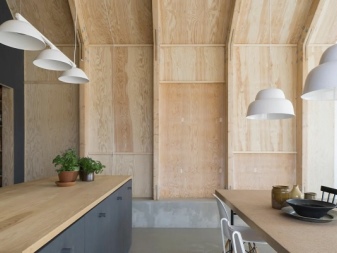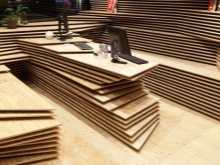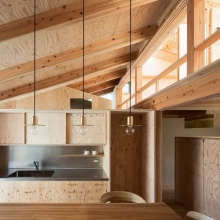All about FC plywood

Plywood is one of the most popular and demanded sheet materials in the world, which still has not lost its immense popularity, even despite the rapid spread of plastic.... At the same time, it is completely wrong to think that any plywood is exactly the same - in addition to the fact that different factories make it in different qualities, it can also differ in its planned characteristics.
All lists of the most common varieties include FC plywood. Let's figure out what it is in order to use it correctly.


What it is?
Plywood FC belongs to the most common grades of material, due to the fact that it is relatively inexpensive, while its technical characteristics satisfy most household needs. The decoding of its abbreviation in the context of specific parameters is as follows: this is a sheet made from either purely coniferous veneer or with deciduous impurities. The layers are joined using urea glue.
In general, such material has relatively low density, and therefore low weight - it is convenient to transport it to any distance. Even a low density does not mean that the sheet is not suitable for significant mechanical stress.
At the same time, the material is distinguished by good moisture resistance, does not wear out for a long time and is pleasant to the touch.


Separately, it should be said about the safety of such plywood sheets. The composition of FC does not include anything else, except for natural veneer and urea resin, which provides the product with proper environmental friendliness. Thanks to this, plywood can be used even for arranging playgrounds, as well as for cladding interiors, making furniture, and building any short-lived buildings.
There is also a slightly improved version of this plywood known as FSF. You don't have to go into the technical details and do not look for how the name stands: this is the same FC, but with increased moisture resistance. If you have long wanted to build a plywood structure on the street, but have been postponing for a long time, then it is better not to experiment with FC, but the FSF is suitable for these purposes.



Varieties
Depending on the purpose for which the finished product will be used, manufacturers produce FCs of various varieties. Unsanded plywood, whose name is often abbreviated simply to NSh, for obvious reasons costs a little cheaper, because the process of its production is devoid of one of the steps. Due to the absence of a grinding step, the material remains rough, it is not so pleasant to the touch. Such material is produced for construction purposes without aesthetic overtones. A striking example is the back walls of furniture - no one sees them anyway, so why not save a little on their cost, if this does not in any way impair strength, durability, or environmental friendliness.
Do not forget that FC plywood, if necessary, can be painted or faced with other materials., and in this case, too, it does not matter whether it was sanded before or not, and in some cases the characteristic roughness even contributes to better adhesion to the finish.


The polished FC was initially adapted for finishing work in its final form; the front sides of the furniture, various visible partitions and many other details are made from it.Please note that the sheet can be sanded from both sides at once, or only from one side - the marking in these cases, respectively, will be Ш2 or Ш1.
Such a sheet can also be painted to make it more beautiful, but often the manufacturer himself laminates the plywood - thanks to this, it acquires a more aesthetic appearance, and at the same time another outer layer that allows it to more effectively withstand the destructive effects of moisture, temperature extremes and other factors.


Varieties
The woodworking industry practically does not involve waste - veneer of any quality is used for the production of plywood. To roughly understand what you will get, it is worth understanding the standardized grades of material:
- I - there are practically no imperfections on the surface of the sheet, this is an excellent plywood for facing something;
- II - such material is slightly worse than what was described above, small cracks and even warping are possible on its surface, but the manufacturer can seal them with wooden inserts;
- III - defects described for the second grade are present, much less attention has been paid to patching them up, while individual wormholes can have a depth of more than half a centimeter;
- IV - a rough surface, almost completely covered with flaws, its edge can hardly be called even due to the large number of "gnawed" areas, but the unevenness does not exceed 5 mm.



In many cases, the sheet does not need to be perfect on both sides. - if you sheathe the walls with plywood, then the next time you will see the inner side only with a new overhaul. Therefore, in order to save and reduce the cost of their goods, many manufacturers produce sheets of the combined grade, in which one side is made in accordance with a higher standard than the other. They are marked this way - if you see grade 2/4, then it has the front side of the II grade, and the wrong side - the IV grade.
For inexperienced consumers, this may come as a surprise, but in fact, an exact division into varieties is impossible. For example, the line between the first and second grades is very conditional - it is rather difficult to determine at what moment there are almost no defects, and when there are already quite a few of them. Many unscrupulous manufacturers naturally strive to upgrade their products, but the buyer may be disappointed in such a purchase.
To prevent this from happening, especially if you are used to buying plywood in large batches, try to trust those suppliers with whom you have already worked and for whom there have been no complaints.


Marking and dimensions
The parameters of FC plywood are determined by a special GOST 3916.1... Thanks to him, for example, we can find out that FC is not the final sign of material classification, and it also has varieties. So, ordinary FC plywood is moisture resistant, but it would be silly to expect from it that it can be cladding on the street or in the bathroom. The FSF grade already mentioned above is much better suited for solving complex problems - this is facilitated by impurities such as formaldehyde and resins. At the same time, a low-quality FSF also has another marking - Air Force.
If the manufacturer also laminated the plate at the same time, then its marking will be still different - FOF, and then it can be used to build formwork and even more durable structures. There is still FB - Bakelized material, which is processed with special impregnations, which is why it is a cross between wood and plastic.
Its variety under the brand name FBA means the same FB, but glued with natural glue on albumin and casein.



The most important indicator of the ability of plywood to be used in various places is emission class. It is designated as E1 or E2 and shows how much formaldehyde is evaporated into the atmosphere.Such a compound is not at all useful for the human body, because the less it evaporates, the better, and in indoor conditions, as well as for the equipment of playgrounds, it is wiser to use only the most environmentally friendly varieties. These usually include FBA, FK and FB - they have an emission class E1, which means that there is no more than 8 mg formaldehyde per 100 g of plate weight. Moisture-resistant FSF and FOF are mainly used outdoors, not only because they are able to withstand the domestic climate, but also due to the fact that their emission class is E2.
We have already considered the classes of plywood above, it remains only to figure out the dimensions of the sheet - in the standard version, they exist in dozens of varieties. The width and length are usually indicated together, therefore it is difficult to confuse them with something else, especially since the numbers are given in millimeters and therefore turn out to be large - for example, 2440x1220 or 1525x1525 mm. The thickness is also indicated in millimeters, but for obvious reasons the values there will be much more modest like 15 mm, 4 mm, 9 mm.


Selection rules
The main rule of choice is that one should delve into all the existing parameters of plywood in as much detail as possible, know the various markings, clearly understand what they mean. Considering that this is not only a finishing, but sometimes a building material, which, moreover, is not always 100% environmentally friendly, one must be sure that no potentially dangerous properties of plywood have remained behind the scenes. Avoid making a choice in favor of the plywood that differs from the one you need "by only one or two points", while being cheaper.
Before purchasing, think carefully about what the ideal plywood should beat to solve the task, and do not deviate from the requirements even a step. Agree, it would be strange to use theoretically toxic plywood in a nursery simply because such material costs a little less. Saving is also inappropriate if the moisture resistance class of the material is lower than required, or if the product turns out to be so rough that it loses its aesthetics and can become a source of splinters.
You should also not ignore trusted manufacturers - if in all other industries brand orientation is considered a sign of an inexperienced consumer, then when choosing plywood it will protect you from the manipulation of standards that some factories love.



Usage Tips
When purchasing plywood, many consumers do not treat it carefully enough in the process of delivery and storage, as a result of which the material is unable to reveal all its advantages. If you work with this material intensively and a lot, and you often have unused material next time, you should know and strictly follow the recommended rules for storing plywood. Considering that FC has only relative moisture resistance, it must be stored indoors without excessive humidity. Since the material itself can already have an aesthetic appearance, the warehouse should ideally also be clean. The same requirements are also relevant for transportation - it is unacceptable to transport FC in a truck with an open body.
The strength of this type of plywood sheet is far from unlimited, therefore storage is carried out not too high in stacks so that the lower sheets can withstand the pressure of the upper ones. Plywood of this type can be stored in rows of no more than 5 pallets in height, and even then - every half a meter, an intermediate stacking of bars is made. With absolutely correct observance of the stated conditions, plywood of the FC type is preserved for 3 years. Theoretically, it can be used after that, but it should be understood that the performance characteristics of the material have already inevitably decreased.
For this reason, you should not use stale plywood to build anything that will have to withstand any significant load.



In the next video, you will find additional information about the grades of plywood according to GOST.













The comment was sent successfully.